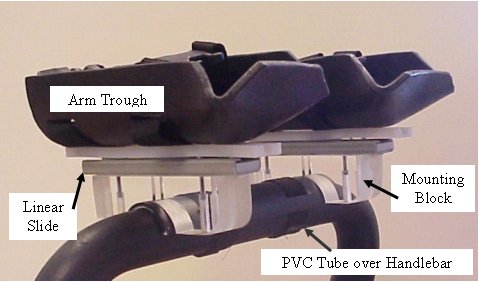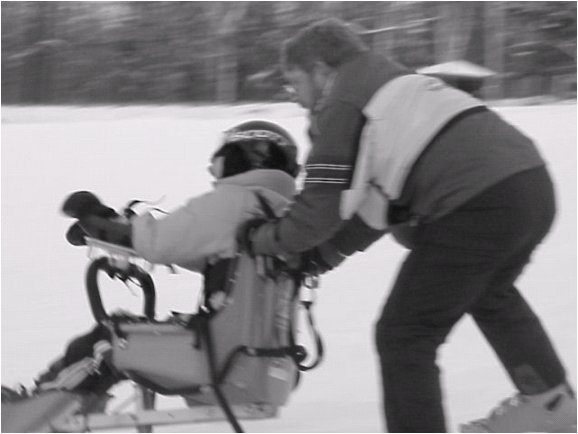DESIGN OF A DYNAMIC BI-SKI ARMREST MECHANISM
ABSTRACT
A dynamic armrest attachment was designed for a Mountain Man bi-ski. The armrest allows the skier to control forward and aft motion of the forearms independently, while providing a comfortable and safe interface with the ski.
BACKGROUND
The Mountain Man bi-ski, manufactured by FFS Dual Ski, Bozeman, Montana, is typical of adaptive skiing equipment at many ski areas. The ski features a rigid molded fiberglass seat attached to two skis. Skiers can use either hand-held outriggers or fixed outriggers and a handlebar attached to the ski. When the ski is properly fitted to the skier, it is precisely balanced. Thus, even small movements will allow the skier to control the behavior of the ski [1,2].
STATEMENT OF PROBLEM
An individual with athetoid cerebral palsy has been using a bi-ski at various ski resorts throughout New England on a regular basis. However, the individual has no functional use of his extremities, and his arms are normally restrained to control his spasticity. While using the bi-ski, he uses the fixed outriggers. In the past, his hands have been secured to the handlebar using duct tape. This is not only unattractive, but also poses a safety problem if the skier must be quickly evacuated from the sit-ski. The skier requested an adaptation to the ski that would limit his arm movements, but still allow some forward and aft motion that could be used to control the ski.
RATIONALE
Typical bi-ski users are individuals with cerebral palsy, muscular dystrophy, multiple sclerosis, spinal cord injuries, or brain injuries. Adaptive skiing programs allow these individuals with disabilities to set goals for personal achievement, experience nature, and improve coordination and balance [3]. Improving the user interface with the bi-ski will allow users with limited upper extremity motion and control to have more control over the motion of the ski and improve comfort and safety.
DESIGN AND DEVELOPMENT
The sit-ski adaptive armrest mechanism was designed by a group of students in an introductory mechanical engineering design class. Three teams of four students each developed preliminary design concepts and prototypes of their designs. The students interviewed the disabled skier to determine his needs, and consulted with him throughout the development process. Inclusion of the client as an integral part of the design team is recommended as part of the development of assistive technology. Specifications for the design included safety and comfort of the user, quick and easy mounting to the ski, light weight, and weather resistant. The final design incorporates design elements from each of the three teams, along with suggestions from the intended user.
The sit-ski armrest consists of two molded ABS arm troughs, each attached to a spring-loaded linear slide. The slides, fabricated from galvanized steel track, are mounted on blocks, which are spaced five (5) inches apart on a piece of PVC tubing sized to fit over the handlebar of the sit-ski. Straps made from nylon webbing with quick-release buckles are used to restrain the skier's arms in the arm troughs; similar webbing and simple slide fasteners are used to mount the device to the sit-ski handlebar. The prototype device can be mounted on the handlebar of the ski and the user's arms secured in less than three minutes. The armrest is shown in Figure 1 mounted on the sit-ski handlebar.
 |
EVALUATION
The armrest mechanism allows the user to translate his arms independently through a total stroke of ±1.0 inch from the neutral position. This motion is achieved through the use of spring-loaded linear slides, with a spring constant of 4 lbs/inch. This motion allows the skier to have some control over the ski through a combination of slight torso motion and elbow flexion, which provides the skier with the ability to accelerate the ski. Side to side balance and control are achieved through head motions. After testing the mechanism, the skier reported improvements in control and maneuverability of the ski. Minor adjustments in the position and orientation of the armrest and removal of the wrist stops on the armrests were also requested to further increase the comfort of the skier. Overall, the user was very satisfied with the device. Figure 2 shows the skier in action.
-
National Sports Center for the Disabled (2002). Techniques and Equipment. Available online at http://www.nscd.org/recreation/technique.html Accessed December 5, 2002.
-
Extreme Adaptive Sports (2002).What is Adaptive Skiing & Sports?. Available online at http://www.sitski.com/whatisit.htm Accessed December 5, 2002.
-
Broadbent, W.(2002). Ability Plus, Newsletter. Available online at http://www.abilityplus.org/newslet/willway.html Accessed December 5, 2002.
 |
ACKNOWLEDGEMENTS
The authors would like to thank the students in WPI's ME2300 Introduction to Engineering Design class (Spring 2002) for development of the first stage prototypes of the design. Rick Patrick and Kevin Shea from the Wachusett Mountain Adaptive Ski Program in Princeton, MA provided assistance in understanding the function of the bi-ski, and made their equipment available to the designers for fitting. Finally, Scott Putnam from the Center for Living and Working in Worcester, MA provided the inspiration for this project and enthusiastically tested the armrest.
Holly
K. Ault PhD.
Mechanical Engineering Department
Worcester Polytechnic Institute
100 Institute Road, Worcester, MA 01609-2280
Phone: 508-831-5498
Fax: 508-831-5680
email hkault@wpi.edu
